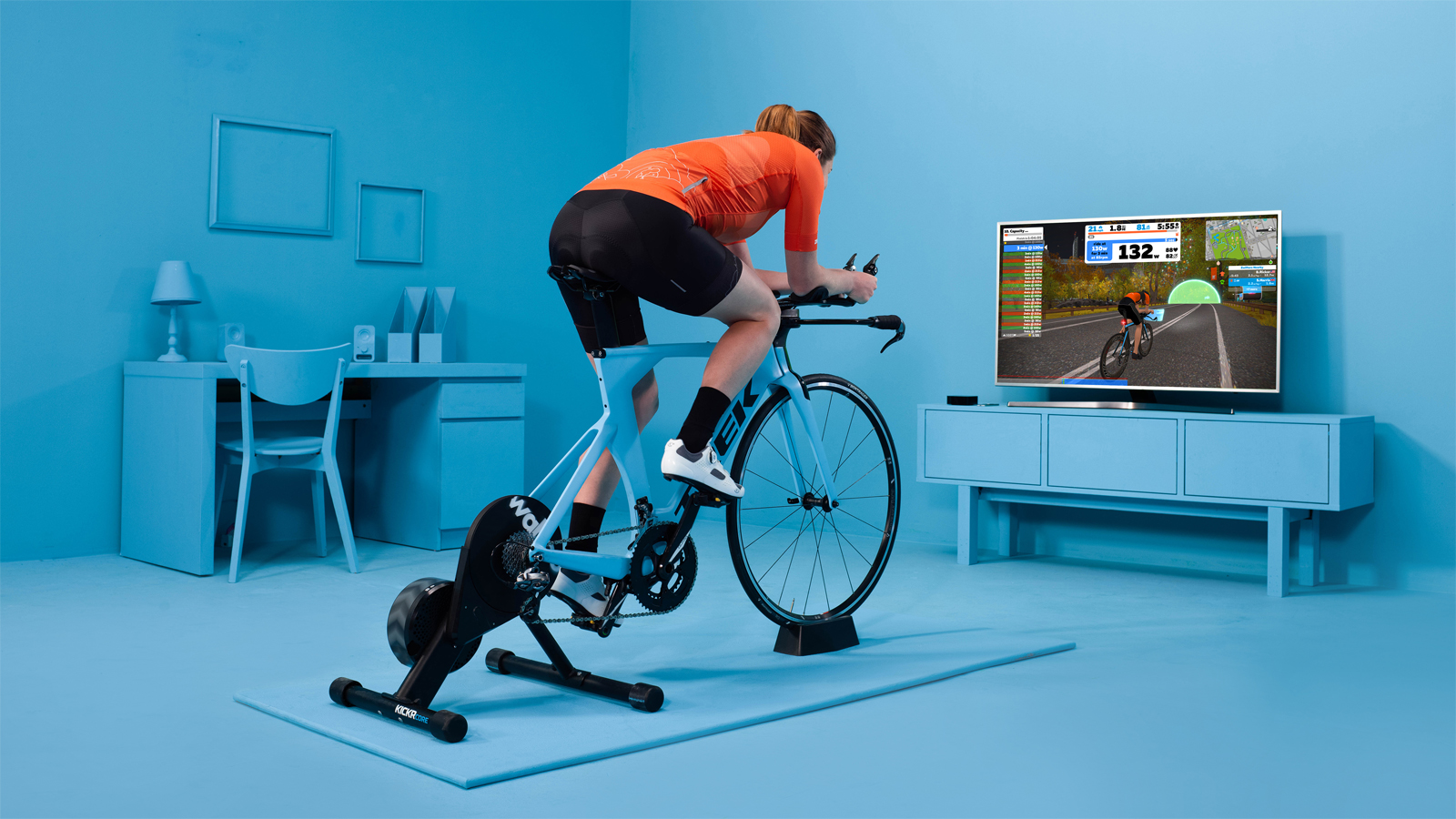The benefits of training indoors for an event
Don't let winter, lockdown, extreme heat or even broken collarbones put a damper on your training. Riding indoors can solve many problems when trying to maintain training consistency

Winter is here for those of us in the Northern Hemisphere, and as we found out with the finale of Game of Thrones, it’s often a pretty grim outlook. Not least when it comes to keeping on top of your training whilst trying to dodge downpours, avoid icy roads and work around shortened daylight hours - and that's assuming you're allowed out at all, what with half the world in various forms of lockdown again.
Luckily, indoor cycling has advanced over the past few years, and as a result, it now provides a platform that can genuinely benefit the training cyclist looking to get faster, whilst simultaneously providing engaging social interaction that helps to occupy the mind while the legs are doing the work.
In fact, with the advancement in technology and the introduction of smart indoor trainers, smart bikes and indoor cycling apps such as Zwift, training indoors has become one of the most effective ways of preparing for an event, and many would argue it is now more effective than training outside, thanks to the controlled environment it enables.
One of the biggest misconceptions associated with indoor training is that each session has to be hard or fast. However, indoor sessions should typically follow the same structure as their outdoor counterparts, and a training plan should do likewise.
Training indoors
Training for an event indoors can be really effective, as it's easy to replicate any session that you are able to do outside on a smart trainer while reducing the overall time. For HIIT, Threshold or Tempo efforts, the session can simply be copy-pasted to the new format. However, for endurance efforts, an amount of leeway can be applied.
As a coach, I personally allow for an endurance training session to be reduced by up to 25 per cent when performed indoors. For example, a two-hour Z2 ride (easy endurance ride) can be reduced to 90 minutes when you have to do the session indoors. The reason for this is that the best turbo trainers can use ERG mode, which controls the resistance to ensure the power output remains steady, no matter the cadence. With the omission of downhill freewheeling, traffic lights, junctions and other interruptions, an indoor ride can provide similar stimulus in less time.
The benefits of training indoors
1. Time efficiency
Get The Leadout Newsletter
The latest race content, interviews, features, reviews and expert buying guides, direct to your inbox!
The single biggest benefit of training indoors is time efficiency. A smart turbo trainer allows us to fit more quality work into a shorter time, which is a major positive for the time-constrained individual. When indoors, every second of your training session is spent placing the exact desired force and workload through your pedals. Outdoor riding, on the other hand, can result in as much as 30 to 40 per cent of the time spent producing little if any power at all, due to negative gradients, traffic lights and other road furniture.
2. Endurance
As mentioned earlier, the constant resistance of a smart trainer supplies a greater stimulus when performing the same session as you would outdoors. This is due to the constant effort compared to the freewheeling, stopping or drafting that occurs outdoors.
3. Safety
Training indoors removes all the outdoor-related dangers such as traffic, dangerous roads, or climate extremes, making it favourable for individuals living in areas not suitable to cycling outside at certain times of the year. It also provides an alternative to heading out alone in the dark in areas that are not completely safe.
So if there's ice on the ground in a wintery Scotland, you can avoid the potential dangers of black ice whilst still putting in the pedal strokes. Alternatively, if you're in 40-degree heat in summertime Sydney, the extreme heat can quickly divert your bloodflow away from your muscles in order to keep you cool, so turn on the AC, crank up the fans and enjoy a ride at the optimum temperature.
4. Precision
Paired with contemporary smart turbo trainers, software is able to precisely control the resistance, which is increasingly beneficial when performing interval workouts. You are also not limited by local terrain. Smart trainers linked to online training platforms allow you to complete intervals using 'ERG' mode, all you need to do is keep the pedals turning.
5. Injury
We're by no means suggesting you should train through an injury without seeking professional medical advice, but for those sidelined from cycling due to hand or arm issues relating to bike control, indoor cycling's static nature can potentially offer a solution.
For example, just 43 days separated Mat Hayman breaking his arm during a crash at the 2016 Omloop Het Nieuwsblad and his win at Paris-Roubaix. He couldn't hold the handlebars, let alone control a bike after his crash, so he rigged up a ladder over his turbo trainer to rest his arm and set about training.
A similar example was set by Steve Cummings. The Briton broke his collarbone, sternum and scapula in a crash at the Tour of the Basque country, but 11 weeks later he rode to both time trial and road race success in the British National Championships.
6. Lockdown
If, like many areas around the world, you find yourself in lockdown, you may be forbidden entirely from heading outdoors to exercise. In this case, indoor cycling may provide your only option to continue training, in the hope that the vaccines are able to return the world to a semblance of normality by the time spring rolls around again for the Northern Hemisphere.
How to overcome the potential perils of indoor training
1. Heat
As humans, we are relatively inefficient at converting stored energy into power. The remainder gets lost as heat, which has to go somewhere. When we ride outdoors our bodies keep cool through evaporative and convective heat loss. While riding indoors we are not moving through the air, which leads to a rapid increase in core temperature and copious amounts of sweat covering the body.
Solution: Buy the biggest fan you can get your hands on, place it directly in front of your stationary trainer and turn it onto full blast during your workouts. Additionally, you should use an absorbent towel and be prepared for some heavy sweating. Many e-racing cyclists will opt for multiple fans and use WiFi-enabled smart plugs to allow them to add extra wind when the going gets tough, without having to start a ride in gale-force winds or stop mid-ride.
2. Boredom
Riding indoors is one of the most mentally challenging aspects of training. Without the mental stimulation of routing, bike control and a passing landscape, it requires some real dedication to sit in one spot for hours on end.
Solution: Indoor cycling apps. Zwift, for example, has provided everyone with access to a platform that introduces a good level of entertainment. Sign up for a small fee and reap the rewards of group training rides, explore the various courses, challenge for a KOM or try to keep up with one of the many WorldTour pros using the platform. RGT allows you to replicate real courses using its Magic Roads feature - which is great for hyper-specific event preparation. Alternatively, watch the latest 'cross race while following your TrainerRoad session, or jump into Wahoo SUF and you'll be given real first-person racing footage to keep your mind focussed while your legs suffer.
Jarred Salzwedel completed his Honours degree in Sports Science at the Nelson Mandela Metropolitan University in 2013. His Master's degree focused on investigating training adaptations to differing high-intensity interval training programmes in cyclists.
He has raced both on the road and track at a National level in the Junior ranks which led to his interest in the science behind training and conditioning, as well as his passion to help athletes optimise their performance.
Jarred owns and manages Cycle Dynamic Coaching - a coaching platform that looks after and advises some of South Africa’s top Road and Track cyclists. He has extensive knowledge in exercise physiology having previously focused on the physiological testing of endurance athletes.
